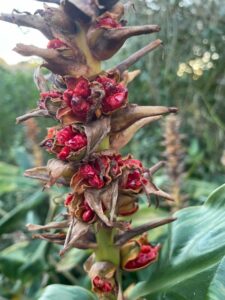
Anthropogenic climate change is visible at Ventnor Botanic Garden in many ways. Our comparatively cold winter in 2022/23 seems at odds with our allegorical claim to be Britain’s Hottest Garden, but it actually highlights the anticipated consequences of global heating: more unsettled seasonal weather patterns and more extreme meteorological records. Buried beneath the statistics and measurements are tangible signs from the plant kingdom of a different climate to that of 150, 75 and even 30 years ago.
Hedychium gardnerianum (pictured) is an introduction from the Himalayas. It has exotic lush foliage and tropical looking flowers, finding a place in British gardens as a subtropical plunge plant suitable for summer displays, only to be brought indoors for winter. Traditional expectation for this plant would be death from cold in a freezing winter, but at VBG it has maintained a permanent presence out of doors for many years. In milder climates still, such as warmer parts of the USA, it has become a weed. On the Azores it is pernicious, outcompeting the at risk native flora. Look closely at the picture, those are seeds within the bracts. At VBG we are at an important cross-over point, these plants are no longer just examples of our remarkably mild climate, but are at the tipping point of becoming weedy as viable seeds are cast even in the cold of our current winter.
